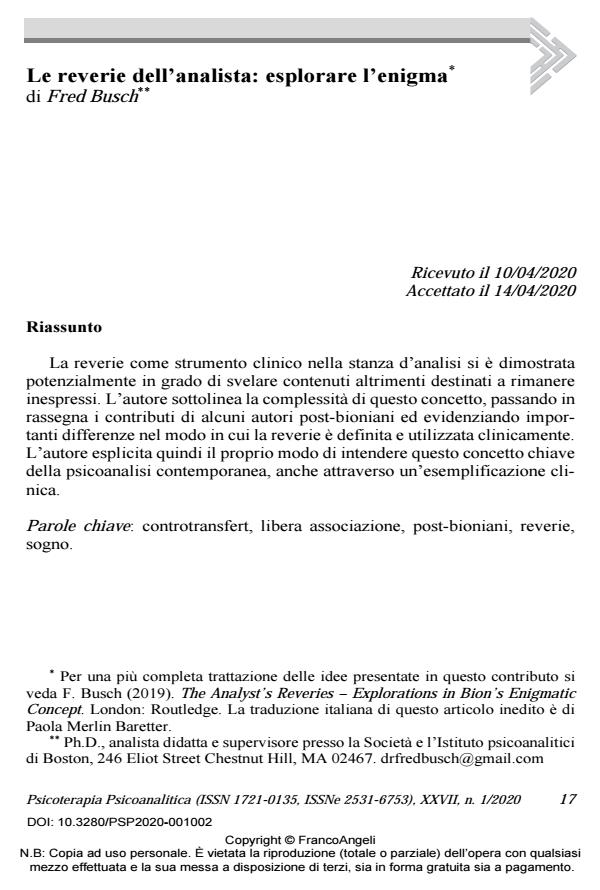Le reverie dell’analista: esplorare l’enigma
Titolo Rivista PSICOTERAPIA PSICOANALITICA
Autori/Curatori Fred Busch
Anno di pubblicazione 2020 Fascicolo 2020/1 Lingua Italiano
Numero pagine 22 P. 17-38 Dimensione file 221 KB
DOI 10.3280/PSP2020-001002
Il DOI è il codice a barre della proprietà intellettuale: per saperne di più
clicca qui
Qui sotto puoi vedere in anteprima la prima pagina di questo articolo.
Se questo articolo ti interessa, lo puoi acquistare (e scaricare in formato pdf) seguendo le facili indicazioni per acquistare il download credit. Acquista Download Credits per scaricare questo Articolo in formato PDF

FrancoAngeli è membro della Publishers International Linking Association, Inc (PILA)associazione indipendente e non profit per facilitare (attraverso i servizi tecnologici implementati da CrossRef.org) l’accesso degli studiosi ai contenuti digitali nelle pubblicazioni professionali e scientifiche
La reverie come strumento clinico nella stanza d’analisi si è dimostrata potenzialmente in grado di svelare contenuti altrimenti destinati a rimanere inespressi. L’autore sottolinea la complessità di questo concetto, passando in rassegna i contributi di alcuni autori post-bioniani ed evidenziando importanti differenze nel modo in cui la reverie è defini-ta e utilizzata clinicamente. L’autore esplicita quindi il proprio modo di intendere questo concetto chiave della psicoanalisi contemporanea, an-che attraverso un’esemplificazione clinica.;
Keywords:Controtransfert, libera associazione, post-bioniani, reve-rie, sogno.
- Aguayo A., Malin B. (2013). Los Angeles Seminars and Supervision. London: Karnac.
- Baranger M., Baranger W., Mom J. (1983). The infantile psychic trauma. Int. J. Psycho-Anal., 69: 113-128. DOI: 10.4324/9780429483806-
- Bion W.R. (1962). Apprendere dall’esperienza. Roma: Armando, 1972.
- Birksted-Breen D. (2012). Taking time: the tempo of psychoanalysis. Int. J. Psycho-Anal., 93: 819-835.
- Birksted-Breen D. (2016). Bi-ocularity, the functioning mind of the psychoanalyst. Int. J. Psycho-Anal, 97: 25-40. DOI: 10.1111/1468-5922.12342
- Bolognini S. (2004). Intrapsychic-Interpsychic. Int. J. Psycho-Anal., 85: 337-357.
- Breuer J. (1893). La signorina Anna O. In: Studi sull’isteria. OSF, 1.
- Busch F. (2014). Creare una mente psicoanalitica. Un metodo e una teoria psicoanalitica. Roma: Armando, 2016.
- Busch F. (2015). Our Vital Profession. Int. J. Psycho-Anal., 96: 553-568. DOI: 10.1111/1745-8315.1234
- Busch F. (2019). The Analyst’s Reveries. Explorations in Bion’s Enigmatic Concept. London: Routledge.
- Cassorla R.S. (2013). In search of symbolization. In: Levine H.B., Reed G.S., Scarfone D. (eds.). Unrepresented States and the Construction of Meaning. London: Karnac.
- da Rocha Barros E.M. (2002). An Essay on Dreaming, Psychical Working out and Working Through. Int. J. Psycho-Anal., 83: 1083-1093. DOI: 10.1516/E57V-RPQY-EKNY-2AJ
- da Rocha Barros E.M., Da Rocha Barros E.L. (2016). The function of evocation in the working-through of the countertransference: projective identification, reverie, and the expressive function of the mind. Reflections inspired by Bion’s work. In: Levine H.B., Civitarese G. (eds.). The W.R. Bion Tradition. London: Karnac.
- da Rocha Barros E.M. (2018). Symbol formation and transformations in theory and practice. Presented to the 43rd Annual Conference of the Canadian Psychoanalytic Society. Montreal, June 2018.
- de Mattos J.A.J. (2016). Impressions of my Analysis with Dr. Bion. In: Levine H.B., Civitarese G. (eds.). The W.R. Bion Tradition. London: Karnac.
- Diamond M.J. (2014). Analytic Mind Use and Interpsychic Communication: Driving Force in Analytic Technique, Pathway to Unconscious Mental Life. Psychoanal. Q., 83: 525-563.
- Eagle M. (2003). The Postmodern Turn in Psychoanalysis: A Critique. Psychoanal. Psych., 20: 411-424. DOI: 10.1037/0736-9735.20.3.41
- Ferro A. (1996). Nella stanza d’analisi. Milano: Cortina.
- Ferro A. (2008a). Rêveries. Torino: Antigone.
- Ferro A. (2008b). The Patient as the Analyst’s Best Colleague: Transformation into a Dream and Narrative Transformations. The Italian Psychoanalytic Annual, 2: 199-205.
- Ferro A. (2008c). Clinical Implications of Bion’s Thought. Int. J. Psycho-Anal., 87: 989-1003. DOI: 10.1516/8TG7-F1WU-RLG7-QUV
- Ferro A. (2009). Transformations in Dreaming and Characters in the Psychoanalytic Field. Int. J. Psycho-Anal., 90: 209-230.
- Ferro A. (2017). Pensieri di uno psicoanalista irriverente. Guida per analisti e pazienti curiosi. Milano: Cortina.
- Ferro A., Nicoli L. (2017). The New Analyst’s Guide to the Galaxy. London: Karnac.
- Green A. (1975). The Analyst, Symbolization and Absence in the Analytic Setting (on Changes in Analytic Practice and Analytic Experience) in Memory of D.W. Winnicott. Int. J. Psychoanal., 56: 1-22. DOI: 10.4324/9780429478024-
- Green A. (1992). Book Review, Cogitations. Int. J Psychoanal., 73: 585-589.
- Grotstein J. (2009). Il modello kleiniano-bioniano. Vol. 1: Teoria e tecnica. Milano: Cortina.
- Katz Montana S. (2016). The timing of the use of reverie. In: Blue D., Harrang C., From Reverie to Interpretation. Transforming Thought into the Action of Psychoanalysis. London: Karnac.
- Kern J. (1978). Countertransference and Spontaneous Screens: An Analyst Studies His Own Visual Images. J. Amer. Psychoanal. Assoc., 26: 21-47. DOI: 10.1177/00030651780260010
- Kernberg O. (2017). Wilfred Bion: Los Angeles seminars and supervision. Int. J. Psychoanal., 98: 250-253. DOI: 10.1111/1745-8315.1244
- Lecours S. (2007). Supportive interventions and nonsymbolic mental functioning. The International Journal of Psychoanalysis, 88: 895-915. DOI: 10.1516/U7GK-3G8H-1532-2152
- Ogden T.H. (1997a). Reverie and Interpretation. Psychoanal. Q., 66: 567-595. DOI: 10.1080/21674086.1997.1192754
- Ogden T. (1997b). Reverie and Metaphor. Some Thoughts on How I Work as a Psychoanalyst. Int. J. Psycho-Anal., 78: 719-732.
- Ogden T.H. (2007). On Talking-as-Dreaming. Int. J. Psycho-Anal., 88:575–589. DOI: 10.1516/PU23-5627-04K0-750
- Ogden T.H. (2012). Rediscovering Psychoanalysis. Psychoanal. Persp., 6: 22-31. DOI: 10.1080/1551806X.2009.1047303
- Ogden T.H. (2017). Dreaming the Analytic Session: A Clinical Essay. Psychoanal Q., 86: 1-20.
- Ogden B.H. and Ogden T.H. (2012). How the Analyst Thinks as Clinician and as Literary Reader. Psychoanal. Persp., 9: 243-273. DOI: 10.1080/1551806X.2012.71630
- Pine F. (2011). Beyond Pluralism: Psychoanalysis and the Workings of Mind. Psychoanal. Q., 80: 823-856.
Fred Busch, Le reverie dell’analista: esplorare l’enigma in "PSICOTERAPIA PSICOANALITICA" 1/2020, pp 17-38, DOI: 10.3280/PSP2020-001002